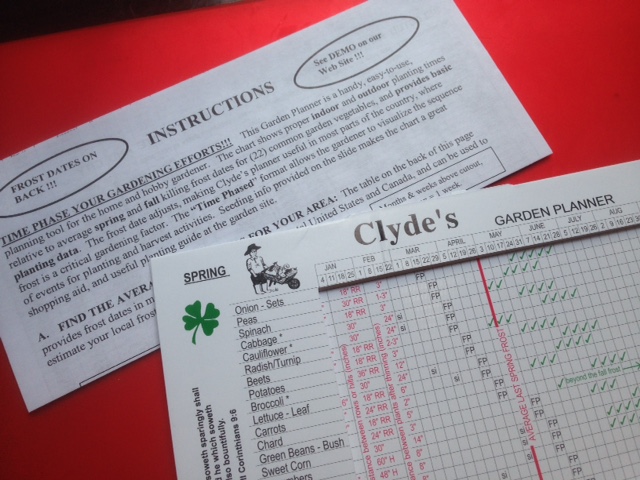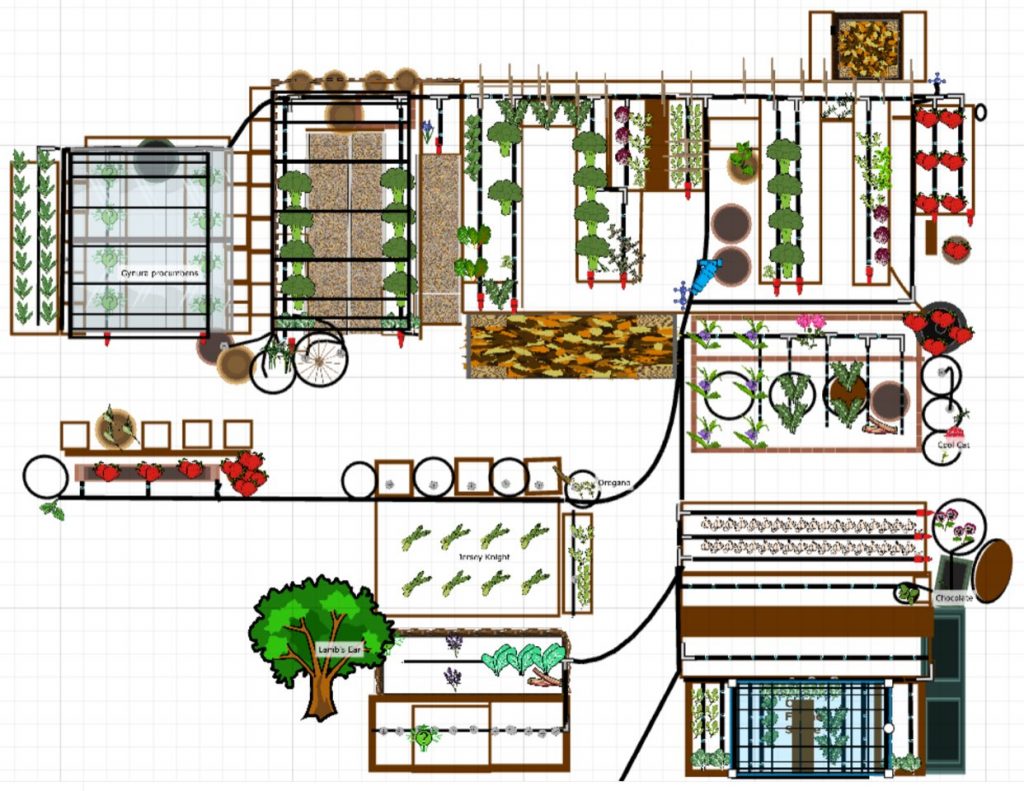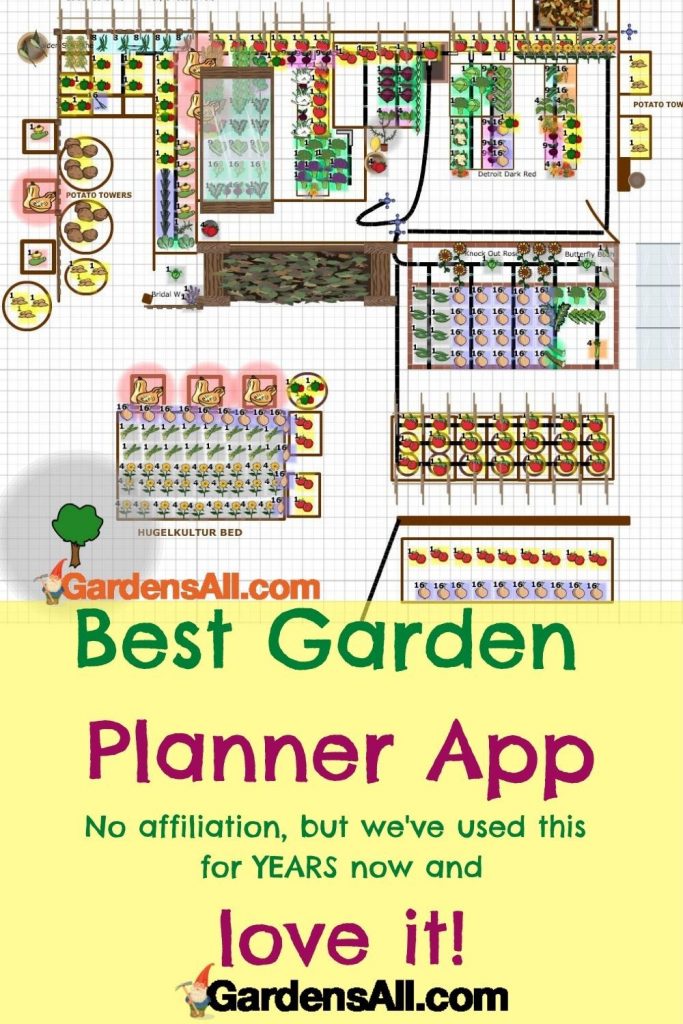Whether it’s in our heads, on the back of a napkin, or laid out to scale over the entire season, garden planning is important for the best success. We’ve found that gardening with a definite plan cuts down on impulse buying and allows us to allocate space for succeeding crops.
Garden planning helps track our victories and, yes, our defeats. With each subsequent year, we’ll know better how and what to grow, especially, if we take notes as we go along. Even simple ones like star rankings next to each crop are quite helpful.
The good news is – It’s never too late — or too early — to plan!
Physical or Digital Garden Planner?
Some people prefer to physically write, plan, track and journal their gardening process. For that, a popular book on Amazon is The Week-by-Week Vegetable Gardener’s Handbook: Make the Most of Your Growing Season by Jennifer Kujawski.
GardensAll.com investigated a few online options ranging from freebies to 30-day free trial subscriptions. We’d traditionally gone the pen and graph paper route for our Square Foot Garden. But circumstances changed and we needed to step out of the box, so to speak, and garden beyond the square foot way.
We launched into Straw Bale Gardening, Hugelkultur, and a variety of container and vertical garden methods.
So, here’s what we’ve checked out so far. If you have experience with either of the ones we mention here or any other, garden planner, please share your experience, we love to learn from you too.

Garden Planning Journals, Books and Guides
There are bunches of hard copy garden planning journals available. One of the best sellers is the long-titled The Garden Journal, Planner and Log Book: Repeat successes & learn from mistakes with complete personal garden records. 28 adaptable year-round forms, … (The Garden Journal Log Books) (Volume 1) by Joy L. Kieffer. Other books of this type are numerous as listed here.
Many of our favorite gardening books, like Joel Karsten’s Straw Bale Gardening and Mel Bartholomew’s classic Square Foot Gardening include plot layouts and scheduling and would be useful for doing a basic (static) plan.
In the slower winter months, we spend a lot of time reading, garnering what we can prior to plugging the next season’s vegetable garden crops into our new layout.
Best Garden Planning Books
We asked the GardensAll Facebook community what gardening books they would recommend and here’s a brief listing of their favorites, all available on Amazon:
- Gardening at the Dragon’s Gate by Wendy Johnson
- 4 Seasons Harvest by Eliot Coleman
- Carrots Love Tomatoes by Louise Riotte
- Gardener to Gardener Seed Starting Primer and Almanac by Viki Mattern
- Farmers of Forty Centuries by F. H. King
- The Market Gardener by Jean-Martin Fortier, (see an article Jean-Martin — The Market Gardener here)
- Turn Here, Sweet Corn by Atina Diffley
- Farm City: The Education of an Urban Farmer by Novella Carpenter
An earlier article on how to decide what to grow, focused on how picking veggies for a garden is ideally akin to the way value investors pick stocks. In order to select a wonderful crop, research matters. Books, magazines, online sources (like ours truly), and checking in with your fellow gardeners will greatly enhance your planning capabilities.
Frost Dates
Please note: Average early and late frost dates for your region are not indicated by the USDA Plant Hardiness Zone Map. This article on plant covers provide good references on where to find key information about your local weather patterns.
Free and Simple Online Planner
With the Gardener’s Supply Company Kitchen Garden Planner you can plug veggies in the spaces, but it seems not to account for the space a plant like zucchini might occupy. You have just the basic list of vegetables but no varieties or delineations such as winter versus summer squash.
The dimensions are limiting as well. This might be good for laying out a very simple “draft” of a garden (it is a freebie, after all) but not much use for getting into the details-which a good planner should actually do.
Vegetable Planting Slide Chart Garden Planner
Another simple planning tool available is Clyde’s Planner. Buy it from Clyde or here on Amazon. It’s $5 for the hard copy chart and $5 for the iOS app. It reminds us of a cross between a slide rule and a calendar.
Looks to be quite useful as a quick all-at-a-glance rendition of the garden: when to plant, grow, and harvest. Like the first planner, this chart also lacks specificity and has a limited selection. However, it does what they say it will do and no batteries or WiFi are required.

The Garden Planner App
This is What We’re Using for Years Now
This app is a more sophisticated—yet fun and simple—application you can use on your computer. We are NOT affiliated, but use and highly recommend this! This online garden planning software has loads of features and functionality. After years of creating plans by hand, we’ve been using this for four years now and are loving it.
NOTE: The latest version of Garden Planner software works on iPads and several tablets provided they have a trackpad or bluetooth mouse connected to them, (although we haven’t tried that, preferring a laptop hooked up to a big monitor). Phones have yet to be supported because of the small screen size.
As of this writing, that’s currently $29 for a continual annual subscription, $40 for a single year, or $70 for two years. That’s actually reasonable money considering how much it does and how much we’re using it. We reference and tweak it virtually daily, and the big picture visual of the garden is enjoyable to look at and share on social media. It also gives you fairly accurate spacing using scaled plant images.
The Garden Plan helps you do so much more than just arrange your garden. It also offers companion planting, spacing you’ll need to account for each of the crop families, harvest dates, and seasonality recommendations.
Perhaps, the biggest bonus is a plant list that builds as you make your selection of plants and identify the varieties. Plant varieties are time tracked and sorted according to companion planting, rotation, and planting distances.
Garden Planning Schematic
After years of creating landscaping plans by hand, it’s amazing and awesome having it all on a computer display versus paper. It’s so easy to add or substitute items, to scale the size, making a different garden plan for each season, and separating your different beds, such as vegetable garden and herb garden. The plant list also has an assortment of fruit bushes and trees.
The design pallette includes containers, structures, raised bed frames, pathways, and drip irrigation components.You can run the layout in Square Foot Garden and/or standard rows or beds.
A familiar feature to graphics users is the separate layering for plants, structures, irrigation, and layout which are easily seen as a unit by clicking “All”. In addition to a standard garden template, there’s a “Square Foot Garden” mode that automatically sets the parameters for spacing per plant.
With the Garden Planner App, you’ll have all the references you need pretty much in one spot. You may even add varieties that are not on the list and write in the spacing and care requirements.
Here’s are examples of our organic garden.
GardensAll Lower Garden Plans 2016-2021
There’s a lot more to remark on the features, but bottom line, this program towers over any of the others we’ve seen. The tasks of planning, scheduling, and tracking are way easier. The color highlights around the plants key into companion planting. There’s also an auto function that lights up with crop rotation warnings.
2016 Summer Garden Plan
Note: Grayish sections indicate row covers.

2017 Summer Garden Plan

2018 Summer Garden Plan

The plant list includes hundreds of garden vegetables, perennials, flowers, herbs, and a selection of fruit trees and bushes. When you click on the “i” button at left and a pop up window displays a wealth of information about each plant.
2019 Summer Garden Plan

2020 Fall Garden Plan
Note: Large grayish covering is greenhouse

Here’s the follow-on winter garden plan from 2020 heading into 2021 with mostly cole crops (broccoli, kale, radicchio, leafy greens and garlic) and strawberries for USDA grow zone 7a
2020-21 Winter Garden Plan
Note: Large grayish section is greenhouse. Lower right plot shows row fabric over arch.

Video Tutorial on Garden Planner App
This video is a virtual tutorial, covering many of the features. See how easy it is to use.
The Cons of the Garden Planner
Early on we had a few missteps and glitches that the on-line support cheerfully resolved:
- The printing feature didn’t work quite right with our page setup. Finally did a work around by using the screen capture and printing that image.
- It would be nice to have more ornamental type plants built into the plant selection options, but that’s more the “landscaping” side of things and it’s easy enough to grab a circle, expand it and call it a dogwood.
- It’s a virtual planner that runs off a cloud, so it does require an internet connection.
Garden Planner – Notes Section
Using the new vegetable garden planner app, we generated the spreadsheet off 2021 plantings and a special column for notes. This is very handy for planning the next season’s.vegetable garden. Note also the color-coded planting times, (indoors and out) and the harvesting dates.

Additional Benefits of the Garden Planner
As a subscriber to The Garden Planner, you’ll receive a monthly newsletter, plus weekly videos of gardening tips that include a comment section. There’s now a new section for daily journaling to track your garden tasks and observations. You can also receive garden planting reminders via email.
The Garden Planner is now available via numerous vendors (we use the Old Farmer’s Almanac) for an annual subscription or for extended time periods. They offer a free 7-day trial so you can test it out.
Let us know what you use and we’ll add it to this article to help folks. GardensAll is about a community of gardeners learning from each other and sharing information. So feel free to share on the GardensAll Facebook Page, or send us an email.

G. Coleman Alderson is an entrepreneur, land manager, investor, gardener, and author of the novel, Mountain Whispers: Days Without Sun. Coleman holds an MS from Penn State where his thesis centered on horticulture, park planning, design, and maintenance. He’s a member of the Phi Kappa Phi Honor Society and a licensed building contractor for 27 years. “But nothing surpasses my 40 years of lessons from the field and garden. And in the garden, as in life, it’s always interesting because those lessons never end!” Coleman Alderson

